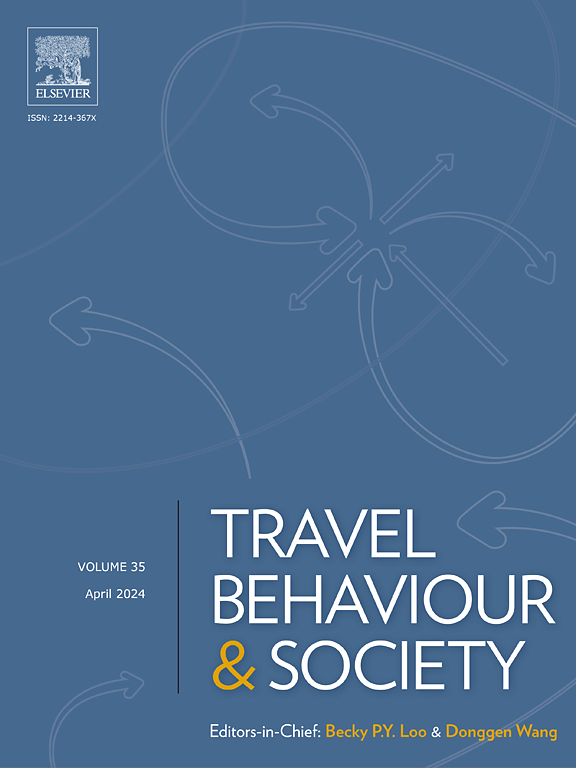Travel-based multitasking reframed? A latent class cluster analysis to identify travel time use styles
IF 5.7
2区 工程技术
Q1 TRANSPORTATION
引用次数: 0
Abstract
Multitasking has become ubiquitous due to expanded possibilities of activity engagement enabled by Information and Communication Technologies (ICTs) and as a strategy to deal with time pressures. In this context, travel time increasingly becomes a space–time locus for activities, including those that save out-of-trip time. This paper proposes that travel time use styles exist, that is, distinct patterns of engaging in travel-based activities. Such styles are uncovered by implementing a latent class cluster analysis of a dataset representing Australia’s Greater Melbourne and Geelong population. We consider activity transfer, multitasking, activity participation, and ICT-related information as indicators of these styles, with traveller characteristics and travel context variables predicting class membership. Four styles emerged: (1) ICT-based effective multitaskers, time-pressured young travellers engaging in multitasking, activity transfer, and multi-activity participation; (2) Time-passers, older travellers of non-passengerised modes who perform leisure activities to pass the time; (3) Heavy work investors, middle-aged, highly-educated, and high-earning workers; and (4) Upkeepers, primarily women and those currently not working. Our results confirm relationships among ICTs, multitasking, and activity transfer, showing how virtual accessibility enables simultaneous and fragmented activities; concomitantly, time pressures necessitate such behaviours. Our findings can serve a dual purpose. From the transport practice standpoint, they can guide vehicle internal space design and minimum ICT provision standards to suit expected travel time use styles. From the behavioural standpoint, they prompt a debate concerning welfare implications of transforming the nature of travel time use from “offline” to “online”, with the associated expectations concerning activity participation requirements and time pressure consequences.
以旅行为基础的多任务处理重新定义?一个潜在的类聚类分析,以确定旅行时间的使用方式
由于信息通信技术(ict)扩大了参与活动的可能性,以及作为一种应对时间压力的策略,多任务处理已变得无处不在。在这种情况下,旅行时间越来越成为活动的时空轨迹,包括那些节省旅行时间的活动。本文认为,旅游时间利用方式是存在的,即以旅游为基础的活动有不同的参与模式。通过对代表澳大利亚大墨尔本和吉朗人口的数据集实施潜在类聚类分析,发现了这种风格。我们将活动转移、多任务处理、活动参与和信息通信技术相关信息作为这些风格的指标,并使用旅行者特征和旅行环境变量预测班级成员。发现了四种类型:(1)基于信息通信技术的有效多任务者、时间压力型多任务青年旅行者、活动迁移和多活动参与;(2)时间过客,即非客运模式的高龄旅客,以休闲活动来消磨时间;(3)重工投资者、中年高学历高收入劳动者;(4)维护人员,主要是妇女和目前没有工作的人。我们的研究结果证实了信息通信技术、多任务处理和活动转移之间的关系,显示了虚拟可访问性如何实现同步和分散的活动;与此同时,时间压力也使这种行为成为必要。我们的发现可以起到双重作用。从运输实践的角度来看,他们可以指导车辆内部空间设计和最低ICT提供标准,以适应预期的旅行时间使用方式。从行为的角度来看,它们引发了一场关于将旅行时间使用的性质从“离线”转变为“在线”的福利影响的辩论,以及有关活动参与要求和时间压力后果的相关期望。
本文章由计算机程序翻译,如有差异,请以英文原文为准。
求助全文
约1分钟内获得全文
求助全文
来源期刊

Travel Behaviour and Society
TRANSPORTATION-
CiteScore
9.80
自引率
7.70%
发文量
109
期刊介绍:
Travel Behaviour and Society is an interdisciplinary journal publishing high-quality original papers which report leading edge research in theories, methodologies and applications concerning transportation issues and challenges which involve the social and spatial dimensions. In particular, it provides a discussion forum for major research in travel behaviour, transportation infrastructure, transportation and environmental issues, mobility and social sustainability, transportation geographic information systems (TGIS), transportation and quality of life, transportation data collection and analysis, etc.
 求助内容:
求助内容: 应助结果提醒方式:
应助结果提醒方式:


